From Dialysis to Incredible Feats of Bodyweight Strength, Katherine Marini Interview
By Adrienne Harvey, SrPCC, RKC-II, CK-FMS
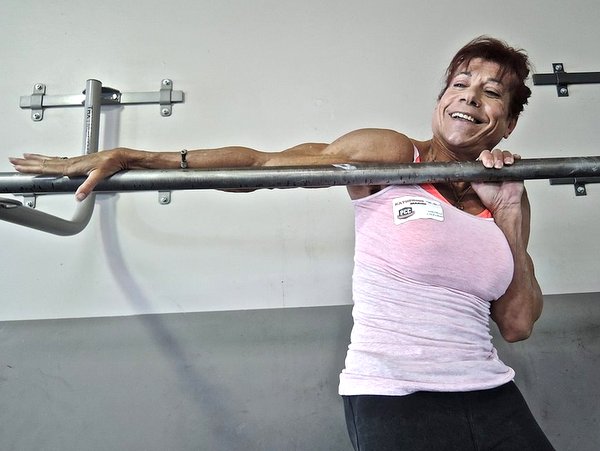
Dragon Door: How did you first get involved with fitness?
Katherine Marini: I have been involved with fitness ever since I was really little. As a teenager, I competed on a national level as an artistic roller skater. After I quit at age 17—and after a couple months of doing nothing—I realized that I needed physical activity to be myself. So, I started going to the gym. I was first certified as an exercise instructor in 1987 and started teaching group exercise classes. Then, while I was in school, I worked in a gym and a nutrition store. I started taking a lot of health and nutrition classes, and fairly early on, was certified as a nutritionist. So, I started training, and I began to train a lot of athletes. I was also doing the nutrition for many physique athletes. It made me want to try it myself, so in the late 90s, I started training for bodybuilding. I also wanted to know how hard it was, so I could better help my clients from experience. My first bodybuilding competition was in 2002, and I did well but not great so I was inspired to do better.
I won my second competition in 2003, and got the opportunity to start my own gym in Encinitas, CA. That was great and I ran it until about 2009. I trained a lot of competitive athletes, and by kind of a fluke, I started getting a lot of clients who were chronically ill or had permanent limitations to their fitness. I was inspired to learn more and created a niche for myself in that community. Little did I know that I would end up in that same community a few years later! Many of the people I worked with had diabetes, brain injuries, or multiple scoliosis. They’d been told that they couldn't exercise, that it was hopeless, or they felt like it was hopeless. It became my mission to help them understand their fitness level and what it could be.
Fitness is unique and individual to each person. What's healthy for one person is not necessarily healthy for someone else, so it has to be very specific and very individualized—especially with certain health conditions. Similarly, if you have a health condition, a healthy diet for you might not look like what others recognize as a healthy diet. This was true for many of my clients—and a good workout for them might be very different from what an average person would think of as a good workout.
What matters most is the attitude and energy they bring, and their expectations. Obviously, with the chronically ill, they need to be smart and listen to their doctors, but they also need to question things and do some of their own research. I think that to succeed in fitness—or anything—you need a certain amount of stubbornness, but also need to be open-minded.
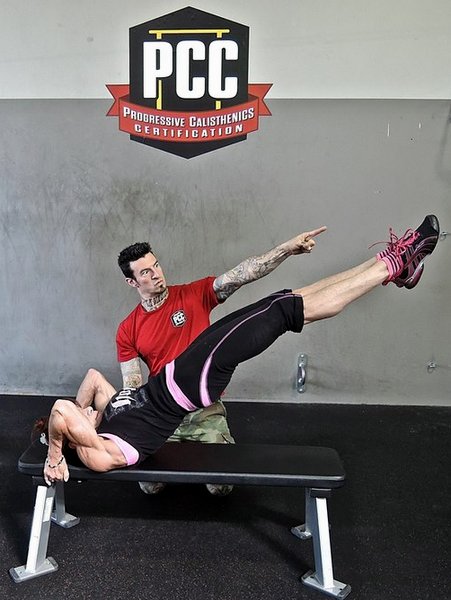
Jumping ahead a little, I wanted to share how this relates to the PCC. During that weekend workshop I had many epiphanies. Many of the things I’ve told myself—or clients—over the years were reiterated by Al and
Danny! The PCC really put it all together for me in a more cohesive way. I’ve always loved calisthenics, even as an unconventional bodybuilder. I once worked in a very unusual gym run by a very old, curmudgeon old-school bodybuilder. He used to say that the more fancy the equipment was, the more useless it was—and that it’s best to stick to simple, elegant, old-school movements. So, the foundation of my workouts has always been built around
push-ups,
pull-ups, and
squats.
Dragon Door: What brought you to the PCC?
Katherine Marini: In 2009, I moved to Florida, and while I didn’t plan on doing a lot of training, I wanted to re-up my certifications. I saw that
kettlebells were getting popular and I started getting interested in the RKC. But I also started getting sick around the same time. Unfortunately, I had end–stage renal (kidney) disease and was on dialysis for five years.
I still exercised and worked out the whole time I was on dialysis—which no one ever does. But I stopped doing two things—I stopped swinging kettlebells because I was nervous that the centrifugal force of the swings would blow out the artery near my fistula, a surgically-created access site on my arm to connect to the dialysis machine during treatments. I also stopped Muay Thai fighting because I couldn’t risk someone accidentally pinning, grabbing, or otherwise constricting my arm.
When I started getting stronger, healthier, and feeling better, I noticed the PCC. It seemed right along the lines of what like what I do, especially since I can't really swing kettlebells. So, I went and of course loved it!
I've been in the fitness industry for a long time, and have met many of the innovators and celebrities. All too often it’s been a disappointment. So, while I was very excited about the PCC, I kept my expectations reasonable. But at the
PCC Workshop these expectations were completely blown out of the water! Al, Danny, and all the other participants were so positive and supportive. I don’t want to get too spiritual about it, but it was a huge experience in my life. It re-motivated and re-focused me. I was beyond impressed—Al and Danny are who they say they are and who they appear to be. That is very, very rare.
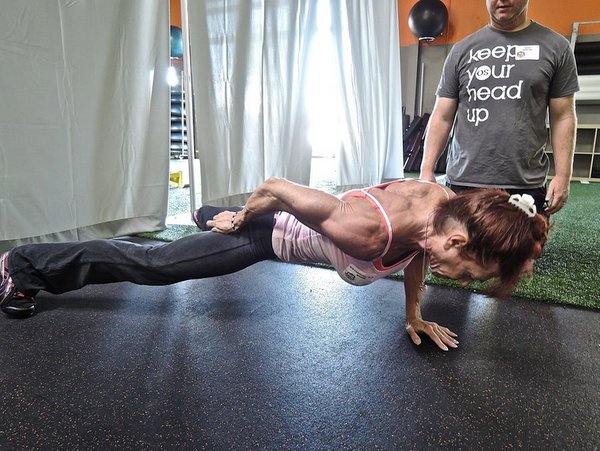
Another thing I like about the PCC is the idea that we are only competitive with our own last achievements—not with other people. One of the first things Al said at the PCC was, "We are not here to compete with each other, we want to be supportive..." And while that’s easy to say, it’s difficult to do, I was impressed to see that everyone at the
workshop actually followed through!
Dragon Door: How are you using what you learned at the PCC to train others?
Katherine Marini: Right now I’m training clients in a gym, even though we use very little equipment. But, I’m in the process of getting a bar setup with a high bar, a low bar, a vertical bar and parallel bars. I want to move it into the backyard to hopefully start training clients at my home. It’s more private and I will have the exact equipment we need. With bodyweight exercises, the joints, cartilage, and ligaments get strong right along with your muscles, so I think there's less risk of injury. And for women who are concerned about getting bulky or unbalanced, there's much less risk with
bodyweight exercises because it develops everything cohesively with a natural balance.
Dragon Door: And bodyweight training can be very convenient—you can do it almost anywhere!
Katherine Marini: Yes, particularly after all the years of people thinking they need special equipment to work out. I don't want to disparage weight training or bodybuilding, because it gave me a good foundation, however, I know a lot of old bodybuilders with terrible injuries, muscle imbalances, and flexibility issues. When isolating and working a specific muscle on a machine, that muscle might get really strong, but the muscles that support it will not be strong. While that isolated approach can set people up for injuries in their lives, I think calisthenics can reverse the effect.
Dragon Door: Yes, since everything has to work together—in calisthenics and in everyday life.
Katherine Marini: Exactly. As a trainer, it is so satisfying to hear a client say, "I went to Costco, got the biggest bag of dog food, and put it in the car all by myself! No one had to help me!" I think that’s what fitness is for—for real life situations.
Dragon Door: I saw many really cool photos from your PCC, what was your favorite move from the workshop?
Katherine Marini: I had no idea that I could do a one arm negative pull up! I also didn’t know that I could almost get up into a
chamber hold. At the workshop, I very briefly got the one arm elbow lever and also the dragon pistol squat!
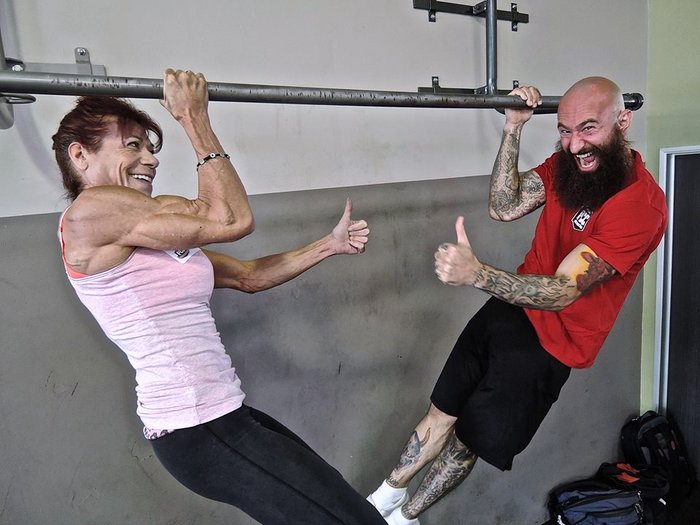
Dragon Door: What are you working on now, after the PCC?
Katherine Marini: I’m working on the dead hang muscle-up, which I am close to being able to do, and eventually, a one arm pull-up. I’m also working on balance and
flexibility more. I enjoy seeing, and trying to copy, some of the crazy yoga poses and strength holds that other calisthenics practitioners post online. The PCC exposed me to a community of like-minded people, which has been really fun.
Dragon Door: What will you be using from the PCC with your current clients?
Katherine Marini: Well, I was also recently certified with a program specifically for teaching the older population stability and fall prevention. Obviously, I'm not going to take a bunch of older people and throw them on the bar, but I will be teaching them bodyweight exercises. It’s especially important for me to bring bodyweight exercise to women, I want them to learn that they can be very strong without looking like the Hulk—and that they don't have to just do a ton of cardio and stretching. Instead they can do something fun like calisthenics. I want to market my training more as playing and practicing than work. I've been telling my clients that they're not scheduling a workout with me, it’s more of a playdate. It's play, practice, and fun, but we are still very focused while incidentally improving our balance, getting very strong, and increasing our flexiblity. All of this can happen without having to run on the treadmill for an hour.
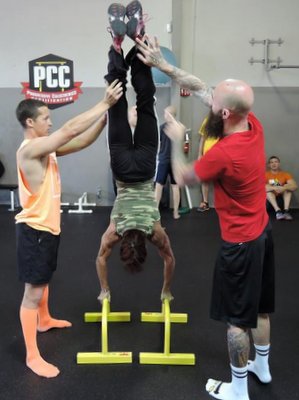
I’m still sometimes shocked by how intense bodyweight training can be! Just yesterday I was working on the elbow lever and doing just one was exhausting. It didn’t seem like I was doing that much at the time. When I wrote the workout, it also didn’t look like too much on paper, but proved to be quite strenuous—and it was fun. So, I am trying to use calisthenics to bring exercise and fitness to people who think that they don't like exercise, and who might not want to go to a gym for a traditional workout.
Dragon Door: That's a great demographic, many people seem to feel that way.
Katherine Marini: I have always found that most of the people who talk to me about training want to want to do it—but they don't really want to do it. They wish they wanted to do it. So I have to figure out how to create the desire to train, and keep them motivated.
Something I wanted to add, when I first got sick and had to be on dialysis for five years, they told me that I wouldn't be able to exercise at all. I wasn’t that upset about being sick, or even upset about dialysis, but when they told me I couldn’t exercise anymore I lost it. I don’t know who I am if I can't move, physically. So, after I caught my breath and focused on educating myself, and doing my own research, I realized couple of important things. They weren’t telling me that I shouldn’t exercise or that it would be bad for me, they meant that no one on dialysis exercises. They were trying to tell me that I shouldn’t expect myself to exercise because I wouldn’t feel like it or wouldn’t want to. But, what I learned was they didn't know me or what I would want to do! I also took the time to learn what exercises would help my condition and which ones I should avoid.
I continued to work out, even though the dialysis definitely made me feel bad and took away a lot of energy. They say that three hours on dialysis, which is standard, feels like eight hours of digging ditches in the hot sun. I also suffered horribly from intense muscle cramps—worse than I'd ever known. I scheduled my dialysis for the last shift of the day, and did my workout and other responsibilities beforehand so after dialysis, I was done for the day.
Eventually, when I would ask my doctors about new and different ideas, they started telling me that I knew more than anyone because of my research and fitness background. Soon, my doctors started encouraging the other patients to talk to me about fitness, diet, and how to stick with their medically-required restrictive diets.
All along, I had refused to get on the transplant list because there were some weird things about my diagnosis which weren’t consistent. I felt like I could eventually come off of dialysis. Of course they sent social workers to talk to me, and who told me that I was being very delusional. I said that maybe I was just being hopeful and not realistic, but it was helping me to think I had a little bit of power. After five years they let me have a trial. I went a week without dialysis (missing three treatments) and did blood work. They fully expected me to need to go back on, but my blood work was a little bit better. Then I went for two weeks without, and my blood work and was a little bit better, then I went for a month. All along, they expected me to need to go to the emergency room for dialysis because I was off of my treatment. Usually people will die within six weeks without dialysis, but after a month I was good, and in two months I was better.
Now, I've been off for a little over a year and I am doing really well. The only medication I take is potassium. It’s unheard of, and I'm fully convinced that staying strong, eating well, believing that it wasn't hopeless was what changed everything. I don’t know for sure, because my condition is different—and I would never tell someone on dialysis that they could necessarily beat it. I always tell people to respect the authorities and don't be stupid—don’t neglect your treatment, but ask questions.
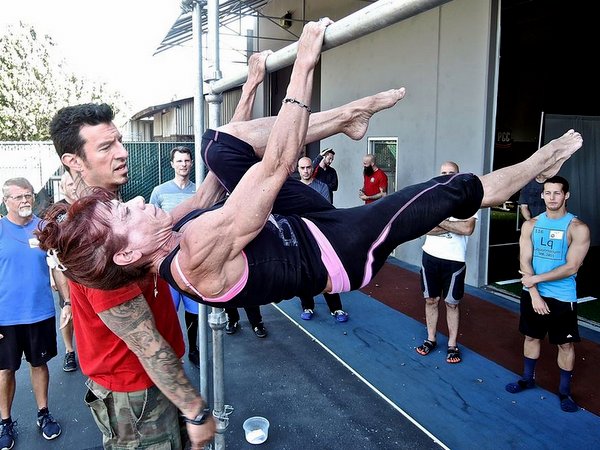
It’s the same as what
Al said at the PCC, "Always question, because the experts don't know you, but you know you". He says to always question, even if it's something he’s saying that doesn’t seem right for you, then maybe it’s not right for you. I think that's what has saved my life more than once—listening to the experts, but also questioning, looking, and finding my own answers. In fitness it is absolutely about finding what works for you.